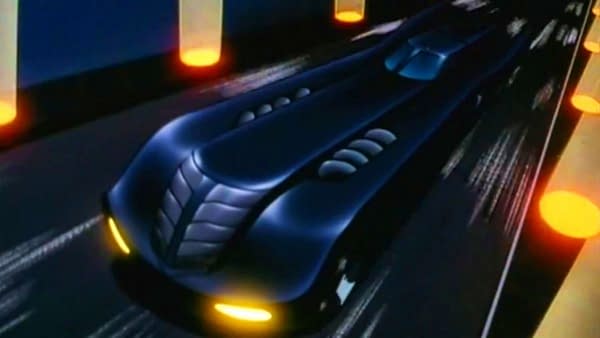Posted in: TV | Tagged: 1992, Batman, Batman Animated, batman returns, batman the animated series, batmobile, bruce timm, bruce wayne, dc comics, fox, FOX Kids, Kevin Conroy, man bat, On Leather Wings, Review, rewatch, tim burton, Warner Bros, Warner Bros Television, warner bros. animation, WB
Batman: The Animated Series Rewind Review: S01E02 "On Leather Wings"
Welcome back Bat-fans as we take a walk down Batmanmemory lane and rewatch Batman: The Animated Series for its 30th anniversary! Today we're going to take a look at one of my favorite episodes and the one that was meant to be the debut adventure for the series, On Leather Wings.

On Leather Wings (Original Air Date: 9/6/1992)
As I alluded to above and mentioned in last week's review, this episode was the first produced and was always intended to be the debut episode of B:TAS. The swap came courtesy of WB and Fox, as they wanted to capitalize on the popularity of the big screen Batman adventure, Batman Returns, and thus bumped what was intended to be the 15th episode, The Cat and the Claw Part 1, which featured Batman's big-screen co-star Catwoman, up to the debut slot in an attempt to get some cross-promotion.
But fans only had to wait one day for things to get back on track, as On Leather Wings aired the very next afternoon, and boy was it worth the wait! This feels much more like a proper premiere episode for the show, as certain characters and iconic things are more present here than in the previous episode. While we don't get a Batman origin story or anything of the sort here, we do get more of a sense of how Gotham City feels about and approaches Batman in this episode than in the previous one.
The official synopsis for the episode: "When a vicious bat creature known as Man-Bat, starts terrorizing Gotham City, everyone mistakenly thinks that Batman is the culprit. Batman must find out who the mysterious Man-Bat is and clear his own name."
So we learn a couple of things right there. The episode features the villain Man-Bat, a not as well-known to the general public Batman villain who debuted in 1970's Detective Comics #400. The episode's title is believed to be inspired by a line from Cormac McCarthy's novel Blood Meridian, which reads, "in the night bats came from some nether part of the world to stand on leather wings like dark satanic hummingbirds and feed at the mouths of those flowers."
So why did they want to launch a new animated series with a lesser-known villain, as opposed to say The Joker or The Riddler or someone surely the wide audience knew from movies or the 1966 show? Series creator Bruce Timm was asked about that in an interview in Modern Masters Volume 3: Bruce Timm and replied with the following answer:
"We designed it as such. That was the first story we thought of when we first started plotting out stories for the show. Man-Bat was chosen specifically because he wasn't familiar to very many people outside comic-book fans. Nobody had any preconceived notions about him. It wasn't like the Joker, where you had to deal with people expecting him to be Jack Nicholson or Cesar Romero. It was kind of like our manifesto. The episode was designed to show you what the show was going to be about. It's not about- even though we were eventually going to do that too–the wacky Joker or the silly Penguin; it's dark, it's spooky, it's mysterious. It has as much to do with mood as it does with action. It was the show in a nutshell, and I think it worked really well in that respect."
It would also be the first use of what would become one of the defining traits of the series: taking a lesser-known or not as respected villain from the comics and giving them depth and pathos to make them into something more. We will see this used to achieve greatness with Mr. Freeze next time and with other characters coming up, but it started here with Man-Bat.
Now let's get to the episode itself. We open on a Gotham Police Zepplin (how cool a design choice is that to make this world timeless?) as they catch something big and flying swooping by on radar. This mysterious thing then makes its way to a pharmaceutical manufacturer and attacks a poor night guard.
What's immediately striking is how this episode doesn't pull any punches for kids. It's presented as a full-on horror/action piece with scary shadows and the feeling of being stalked by something. The imagery as the episode opens of the shadow of a giant creature with sharp talons stalking a victim is evocative of F. W. Murnau's 1922 classic Nosferatu. Not exactly light and fun material to be inspiring a "children's cartoon".
From there we get another interesting introduction to this world of Batman: the politics of Gotham. In a meeting in the Gotham Mayor's office, we see the press, with some help from Police Detective Harvey Bullock, has pinned the crime on the mysterious Batman. Police Commissioner Jim Gordon states his doubts about Batman's involvement while trying to sound as removed from the caped crusader as much as possible, while Gotham District Attorney Harvey Dent promises that if the Police catch Batman, he'll put him away.
This gives non-comic-readers a very unfamiliar and jarring view of Batman and the world in which he operates. Gone is the happy deputized masked agent of the law who parks in front of Police Headquarters and shakes hands with other officers. This Batman is a vigilante, plain and simple. One who's wanted by law enforcement just as much as the criminals he terrorizes. So to have a plot where he's being fingered for someone else's crimes creates some great drama and intrigue.
We then head to the Bat Cave, where Batman (Kevin Conroy) and Alfred (played by Clive Revill in this and two other episodes, before he was replaced by Efrem Zimbalist Jr. for the remainder of the series) investigate the situation. Here we are already given insight into how this Batman is a brilliant detective, first and foremost, as he's already assembled a list of other targets and stolen items relative to the crime he's being blamed for. We also get some humorous back and forth between Batman and Alfred here, showing the show isn't oppressively dark and without heart.
It is also here that we get our first look at Batman's greatest accessory, the Batmobile. The design of the most beloved fictional car in history is wholly original for this series. It doesn't really share much esthetic with any other live-action or comic book design before it (aside from the sliding jet-like canopy seen in Tim Burton's Batman films), yet it's instantly eye-grabbing and feels completely at home in this world. The car, like everything else in the show, feels timeless. There's obviously an influence by old 1930s concept cars here, most notably the 1938 Phantom Corsair, with the bulk of the car's body being in front of the cabin. And yet this thing's a loud, growling beast of a muscle car, complete with all kinds of tricks and gadgets and computer systems that, like the series itself, mix that 1930s/1940s art deco look and fashion with modern technology. Man, do I love this car!

Batman heads over to the scene of the crime to investigate, but right when he finds some evidence (in the form of an audiotape and some hair samples), he's interrupted by Bullock and a SWAT team armed to their teeth. This is great, as we see Batman using his neat tools to do detective work here, along with some of his stealth tactics, such as using knockout gas and smoke capsules to disorient or evade potential threats by nonlethal means.
The action ramps up here as Batman goes toe-to-toe with the Gotham P.D., even as we learn from Gordon that while they have Batman trapped in the building, another pharmaceutical building has just been attacked, thus clearing Batman. The battle has already begun though, and Batman just barely is able to rescue one of the officers after his teammates inadvertently blow-up part of the building.
The next day, Bruce Wayne heads to the Gotham Zoo where he meets some bat experts, a family of scientists who specialize in bat research, led by Dr. Kirk Langstrom (Marc Singer), who works with his wife and her ill-tempered and defensive father, Dr. March (René Auberjonois). Wayne shows them the evidence he acquired as Batman, using the subterfuge that he thinks these items are from bats in his house. The scientists take the evidence to investigate further, as Wayne will continue his own investigation as Batman.
Dr. March calls Wayne to tell him that his evidence shows he just has some common brown bats and starlings fighting over space in his chimney, but Wayne can tell he's lying, as the Bat Computer checked the audio against every known animal species. We go back to the zoo lab, where we see someone burning the evidence that Wayne gave them. They try to fight the urge, but they're overcome and have to drink a serum before wandering off into the shadows. Batman then arrives, sneaking in through a window.
He finds the bottle the serum was in and it's labeled as being from one of the robbed pharmaceutical labs before he's interrupted by Dr. Langstrom. Batman tells him he's looking for Dr. March but is told March is away giving a lecture. Batman reveals he thinks March is the one who's been robbing the labs around Gotham and is the thing he's looking for.
Langstrom corrects him that while March is brilliant and together they created a formula to create an evolved species that combines man and bat. But that he used himself as the test subject and now it's in him and out of his control. He then begins transforming in a particularly creepy and monstrous scene. He becomes Man-Bat and attacks Batman.
As Man-bat makes his flying escape, Batman shoots a grapple around his leg and they begin a death-defying flight around Gotham. The animation for this scene can be described as nothing short of stunning. The camera moves here and the feeling of flight and dodging incoming objects is so incredibly immersive and like nothing we'd ever seen on an afternoon cartoon at this point. The influence of the 1941 Fleischer Studios Superman animated shorts was never more evident than here, especially when you compare how they achieve the sensation of flight and mid-air action in both.
They eventually find themselves in the iron skeleton of a building at a construction site, which adds a great visual element here, giving our characters hard-to-dodge elements as they swoop and fly through it while adding imagery in the foreground and background of the subjects to give the image some real depth.
Batman gets ahold of Man-Bat and rides him right in front of a GCPD helicopter carrying Gordon and Bullock, definitively proving Batman's innocence. After they narrowly avoid a head-on collision with the helicopter, Batman beats down Man-Bat and aims him right into the side of a building, sending them both crashing down to a rooftop below. Man-Bat is knocked out, while a beaten and bloodied Batman lifts and carries the creature into the darkness and out of sight of the Police.
So, Batman being seen bleeding and cut up was a big deal. Kid's cartoons, while plenty violent with fighting and gunplay, were virtually bloodless at the time. In kid's action cartoons up to this point, everyone used laser guns, and injuries were never really shown in any detail. On B:TAS, they used realistic guns that fired bullets, and people, even our heroes, got hurt and showed it. Batman is as beloved as he is because he's a mortal man. There are no superpowers or magic here. So if he's getting whipped around a city skyline by a giant bat creature and hurled into buildings, he's going to be wounded and this show didn't shy away from showing it.
Batman brings Man-Bat back to the Bat Cave and by running through the list of chemicals Langstrom stole to create the serum, he's able to create an antidote. He brings Langstrom, healed and human again, back to his wife and assures her the formula is out of his system and "it's over… for now." This was essential as it showed Batman, not as this Punisher-Esque violent sadist who's simply obsessed with brutalizing those who commit crimes (hi Zack Snyder), but as a caring hero with great humanity beneath a dark visage.
Yes, of course, he terrorizes evil-doers and beats the hell out of plenty of people. But he also feels compelled to help those who are out of control and suffering, which causes them to act this way. For all of the modern hoopla about how Batman should be viewed as simply some kind of fascist neo-con fantasy of crime and punishment, I'd encourage anyone with that idea to watch this series which presents a Batman that is clearly all about criminal rehabilitation and empathy towards those who do wrong due to influences beyond their control.
This episode is an absolute classic for the series and a top fan favorite. It's a near-perfect episode with some groundbreaking imagery and one that takes some daring risks. Shirley Walker's music is in top form here, navigating between horror, action, and even sorrow in a stirring score that elevates every single scene.
This episode along with the entire series is available on HBO Max in full HD.
Next week, we'll cover the most celebrated and awarded episode of the series and one that took one of Batman's sillier gimmick villains and elevated him to the top tear of all supervillains, Heart of Ice.
See you next time Bat-fans!
















